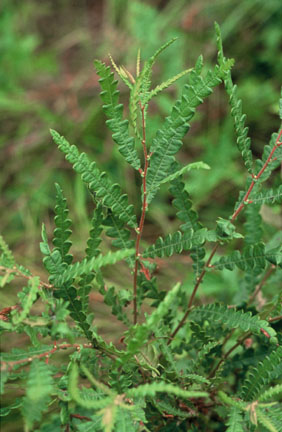|
|
The Herb Traveler – New England
|

|
|
Jewelweed |
herbsdottir on the go
A Natural Remedy For Poison Ivy -
Jewelweed
Down by the water’s edge in August and September, there’s a wild flower that shouts for us to notice her glowing, sunny disposition. She is two to five-feet tall. Her trumpet-shaped flowers are orange and freckled, with a curl to the tail. Her leaves appear
scalloped and her stem is succulent. If you hold one of the leaves under water, it will have a silver sheen.
Might you recognize this helpful plant?
More background forthwith: she is from the genus Impatiens and the
Balsaminaceae or Touch-me-not family. This summer, I have spotted this lovely wildflower in abundance on Cape Cod (especially at the unique Stony Brook Herring Run in Brewster, MA) and at picture postcard views, New Found Lake, New Hampshire. The final clue…this plant has been used by first peoples as a remedy for poison ivy for over 250 years. There does exist a natural, organic remedy for poison ivy!!
Her name is Jewelweed (Impatiens capensis).
 What exactly is Poison Ivy? What exactly is Poison Ivy?
Rhus toxicodendron or Rhus radicans are the botanical names for this three-leafed member of the Cashew family. Appearing in several guises, poison ivy can be a low shrub, or a trailing or climbing vine. To most, a brush-by meeting with this native is always memorable and always unpleasant.
Poison Ivy Rash
Poison ivy rash is an allergic, contact dermatitis caused by a substance called
urushiol (you-ROO-shee-ol), found in the sap of poison ivy, poison oak and poison sumac.
Urushiol is colorless or slightly yellow oil that oozes from any cut or crushed part of the plant, including the stem and the leaves. This oil can be carried on the fur of animals, clothing, on garden tools, or sports equipment. Once it touches the skin, a reaction may be seen in sensitive folks, within 12 - 48 hours in the form of a line or streak of rash. The affected area will display redness and swelling followed by blisters and severe itching.
Prevention and First Aid
The first line of defense is to avoid contact with PI. This means long sleeves, pants, socks and closed shoes for: gardening, hiking, picnicking, jogging, and camping. Dr. Edward Frankel, a poison ivy expert, recommends early treatment with lots of plain, cold, running water.
1. Jump in the lake, jump in the ocean, jump in a cool shower or use a garden hose. “The sooner and longer you shower, the better are your chances of avoiding or minimizing a rash.” Soap is not recommended and neither is warm water as these quicken the absorption of urushiol.
2. Do not scratch! Scratching the skin invites secondary infection. Cut your fingernails short.
3. Jewelweed can help. Here’s how:
 Jewelweed Ice Cubes
Jewelweed Ice Cubes
(Impatiens capensis)
Search damp, shady soils for the juicy stemmed jewelweed plant. Remember, this green friend prefers ‘wet feet’ as does poison ivy. A good resource for drawings and pictures of Jewelweed is
Peterson’s Guide to Medicinal Plants by Foster and Duke. I know that you can also find photographs on the Web.
Collect at least one-half a gallon’s quantity of the plant, stems, leaves, and flowers. Chop into pot-size pieces and toss into a non-reactive pot as Pyrex or enamel. Cover with water, and the pot lid and ‘simmer’ until the water is reduced by one-half and has turned an amber color. Cool. Strain out the wilted herbs and place these in a plastic container with a lid. Refrigerate up to one week.
If you have been exposed to PI, rinse the affected area well and place the wilted herb directly on the area. Create a compress by covering with muslin or cheesecloth for at least 20 minutes.
Step two: Strain the Jewelweed liquid and pour into plastic ice cube trays. Label the trays, ‘Jewelweed’.
When frozen, transfer the ice cubes to Ziploc freezer bags. If anyone has been in contact with poison ivy, a cool wash with the frozen cubes usually does the trick.
|

|
|
Sweet Fern |
Sweet
Fern, (Comptonia peregrina) is another native herb helpful for irritated skin.
It was often used by First Nation tribes in New England.
Sweet Fern is not a fern, but a woody shrub thriving in an acid, sandy,
well-drained soil.
Its lobed, aromatic leaves have astringent and anti-microbial properties.
Used as an external wash, Sweet Fern can soothe a contact dermatitis, reduce
inflammation, itching and help to prevent infection. It is difficult to transplant from the wild, because of a long tap root.
Easier to buy Sweet Fern for your garden at a local garden center.
Harvest Sweet Fern leaves in early summer; dry and store them for later use.
As needed, use the dried leaves in a cool water infusion to counter the effects of poison ivy and insect stings.
Recipe for Sweet Fern Infusion
Utensils:
mesh strainer
large glass measuring cup
cover for measuring cup
clean, soft cloth
Ingredients
3 tablespoons dried leaves of sweet fern
1 - 2 cups boiled water
1. Place the dried, sweet fern leaves in the mesh strainer and place over a large measuring cup.
2. Heat two cups of water till it just comes to a boil.
3. Pour hot water over the sweet fern leaves.
4. Cover and let steep for at least fifteen minutes or until water feels cool to the touch.
5. Remove the strainer with the leaves.
6. Dip a clean, soft cloth in the infusion, wring out.
7. Place over poison ivy rash.
8. Repeat several times for soothing relief.
Campers: Toss some Sweet Fern leaves on the fire to keep mosquitoes at bay.
Do you have another natural remedy for poison ivy? Questions? Comments? Requests for more herbal information?
Contact: herbsdottir101@gmail.com
|